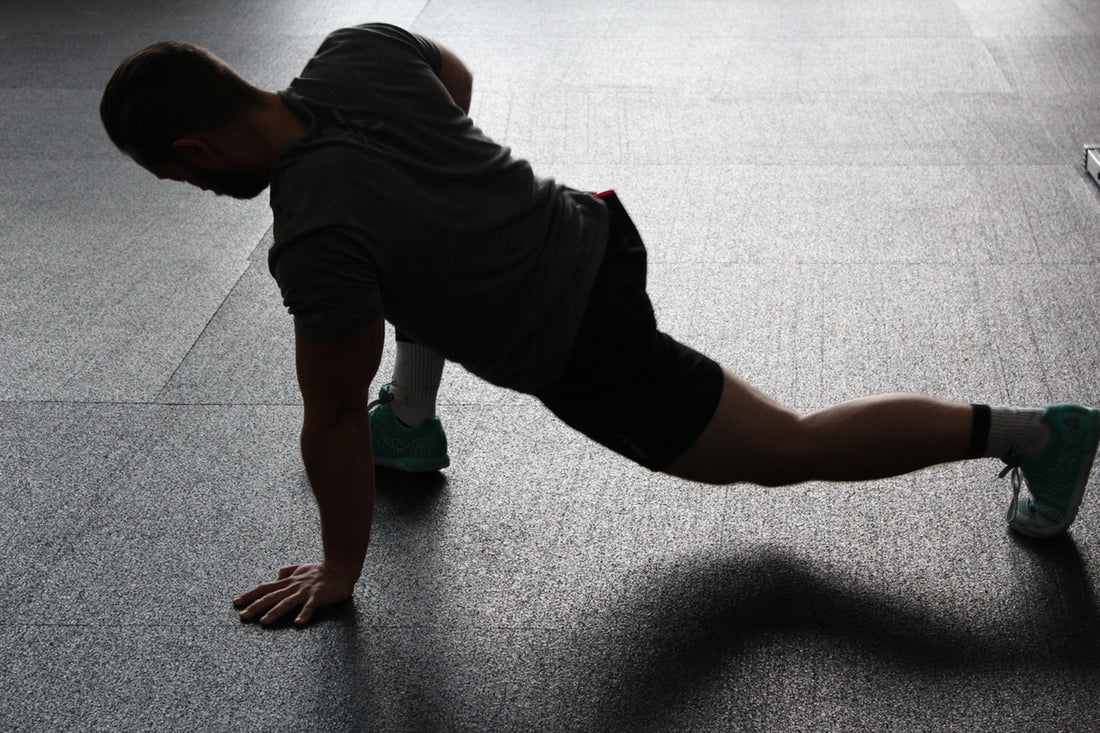Taking the time to stretch after a workout can seem like punishment, especially after a tough workout following the Shredded training program. You’re drained, sore, sweating rivers and hungry. And all you want right now is a shower, post-workout meal, a protein shake and a nap.
I totally get it fam!
We all know how important warming up before a workout is, but most people overlook the post-workout cool down. These post workout stretches, also known as static stretches, can have amazing benefits for your body and are sometimes even necessary in order to minimise workout sessions - especially if you've pushed to 90% limits during the session (which is what I recommend my clients do in Shredded).

In this blog post, I'm going to talk about what static stretching is, why it's important, the best post-workout stretches and why guys following the Shredded workout program should stretching after each workout session.
Let's get started!
What are Static Stretches?
Static stretches involve holding a muscle in a stretched and challenging (but comfortable), position for a short period of time, normally 10 to 30 seconds.
Static stretches are an acceptable and safe way of enhancing all-round flexibility and reducing DOMS and soreness after training sessions. It's generally universally accepted that stretches are best-performed post-activity or after a good workout program because it has been found to reduce performance if done before physical activity.
For improving range of movement for functional movement, however, dynamic stretches pre-workout are considered more beneficial. While both stretches have their pros and cons, today we'll talk about post workout stretches.
The Benefits of Static Stretching for Men and Women
Spending a few minutes after a tough session in the gym to perform static stretches (never mind the occasional ridiculous pose) could prevent injury and do your body a whole lot of good. Static stretches help improve flexibility, enhance your range of motions, relieve stress and lessen the risk of injuries.
Researchers have found solid evidence that static stretches offer therapeutic benefits when performed post-workout.
These are the top benefits of static stretching.
Benefit 1: Enhanced Flexibility
One of the key benefits of stretching is improved flexibility of the various muscle groups in the body. While it’s important for fitness, flexibility also helps to reduce muscular tension. It helps stiff and contracted muscles to relax into their original forms. Regularly performing static stretches after a workout will make your body more flexible in no time.
Bending, squatting, and other flexibility related motions become a lot easier. Working your muscles hard and then stretching them properly helps the muscles adapt to a greater range of motion and makes it possible to optimally use their capacity the next time.
Benefit 2: Eliminates Lactic Acid
Once you begin a workout, your body produces lactic acids which cause muscle fatigue and soreness. Performing proper static stretches will relax the muscles and get rid of the lactic acids.
Benefit 3: Prevents Cramping
Excessive sweating and dehydration while exercising can cause painful muscular cramps. But this is hardly an excuse to skip leg day. Constantly rehydrating with sips of water and stretching those sore muscles will ensure their chancing of cramping up on you are greatly reduced.
Benefit 4: Promotes Muscular Coordination
Static stretches improve the ability of the muscles to work in tandem. Consistent stretching makes this possible, and the resultant benefit is better functional mobility of the body’s muscle groups especially if functional strength training is your thing.

Static stretches after intense weight training session greatly reduce muscle fatigue and tenderness by speeding recovery time. This gets your muscles fired up and thirsting for the next session.
Benefit 5: Cools the Body Down Gradually
Static stretching decreases muscle tension and increases muscle relaxation making it an ideal as a cool-down activity. Also, gentle stretching slows your racing heart at a gradual pace which puts less stress on your heart.
Your body goes back to normal better when you perform cooldown stretches.
The Best Static Stretches
While there are as many types of static stretches as there are muscles groups in the human body, here is a list of essential stretches to cover a wide range of muscle groups and are considered to be most beneficial by sport medicine experts.
Standing Quadriceps Stretch
The quadriceps are large muscles located at the front of your thighs. Asides from looking good on you, they help to move your upper leg, extend your knee and flex your hip. A tight quad can misalign your hips and put excess stress on your hamstrings.
- Stand straight with one hand placed on a wall for balance.
- Lift your right foot backward and hold it in place behind you with your right hand - your right heel should be touching your right butt cheek.
- Pull the foot up towards your glutes while keeping the knee aligned with your hip.
- Hold this position for about 30 seconds and repeat same on the other side.
Seated Forward Bend
The hamstrings are large muscles located on the back of the thighs and extend into your glutes. It causes pulling and pain in your glutes when tight. All three areas can be stretched with the seated forward bend.
- Sit uprightly on the floor with your legs stretched out in front of you.
- Bend at the hips and lower your torso gently toward your thighs.
- Grab your feet, ankles or shin, depending on your flexibility
- Gently pull yourself towards your thighs and hold for 30 seconds.
Cobra Pose
This static stretch routine works your abdominals, chest, shoulders and back at once.
- Lie flat on your stomach on the floor with your legs stretched out behind you.
- Place your hands under your shoulder with your elbows close to your body.
- Lift your head toward the ceiling as you straighten your arms while pressing your hands, pelvis, thighs, and feet into the floor.
- Hold the position for 20 to 30 seconds
Post-Workout Chest Stretch
Bunched up chest muscles can cause a hunched posture. The standing chest stretch can assist to loosen and lengthen your pecs.
- Stand with your feet hip-width apart and align your shoulders, hips, and ankles.
- Clasp your hands behind your back and slowly lift your arms until you feel the tension throughout your shoulders and chest.
- Hold the position for about 30 seconds
Post-Workout Shoulder Joint Stretch
Your shoulders could also benefit from static stretches. The shoulder handles a wide range of motions and involves the humerus, rib cage, clavicle, thoracic region, and scapula.
These complex interactions utilize lots of ligaments and muscles for stability. These muscles and ligaments are therefore prone to stiffness and injury
- Hold out a towel in front of you with both hands
- Slowly raise your arms straight above your head and behind you.
- Hold this position for 30 seconds whilst ensuring the towel is held tightly
Post-Workout Lat Stretch
Your lats or latimissimus dorsi are the powerful muscles that pull your arms closer to your body in exercises like pull up. When they become too tight, they could cause a slouching posture. Loosen up and relax your lats with this simple stretch.
- Put one arm behind your head
- Raise and place the other arm on top of your elbow and gently pull back while stretching your triceps,
- Hold the stretch for about 30 seconds
Post-Workout Groin Stretch
This stretches the groin, inner thighs, glutes, hamstrings and lower back. The groin muscles are some of the biggest muscle groups and function primarily to move the legs. However, they are quite prone to injury.
So, a little post-workout static stretch routine will help keep them limber and prevent injuries.
- Sit on the floor
- Bend your knees and firmly bring your feet together
- Rest your elbows on your knees while holding your feet in your hands
- Gently press down your knees towards the floor with your elbows while keeping your back straight.
- Hold this position for about 30 seconds
Post-Workout Calves Stretches
It’s easy to ignore smaller muscle groups. But your calves deserve some love too because they play a major role in leg movement. Tightness in the calves could cause pain and imbalance.
- Get into a seating position on the floor.
- Stretch out your right leg and bend your left leg at the knees, so the left foot is resting on the inside of the right leg.
- Reach for your right foot with your right hand while bending from the hip and pull it gently towards you.
- Maintain this pose for about 30 seconds
- Repeat on the other side.
Post-Workout Hip Flexors Stretch
Your hip flexors are a muscle group at the top of your thighs that are responsible for moving your lower body. They make it possible for you to walk, kick, bend, and swivel your hips.
Static stretches will keep the hip flexors flexible and prevent tightness which can lead to a hip flexor strain.
- Assume a kneeling position on the floor
- Take a large step forward with your right leg so that you are in a lunge position.
- With your upper body upright, push your hips forward till you feel a stretch on the front of your trailing leg.
- Stay in that position for 20 to 30 seconds.
- Repeat with your left leg forward.
Post-Workout Glutes Stretch
Getting the perfect set of butts seems to be all the rage these days. But with all the lunges, squats, hip thrusts, and step-ups, you need to show your glutes some love- they are about the biggest muscle groups in your body after all.
Static stretches targeting the glutes will improve flexibility and loosen any tension or tightness in the glutes and hips.
- Stand with both feet shoulder-width apart on the floor
- Raise your right leg and rest the ankle on your left knee.
- Press down on your right knee with your right elbow while bending your left knee in a single leg squat.
- Hold the pose for about 30 seconds.
- Repeat with the other leg
This list is not exhaustive. But getting started on these basics will go a long way to maximize your workout and enable you to attain your fitness goals faster, including building muscle, losing fat and getting abs.

As a general safety guideline, static stretches should never be painful. If a technique causes you pain, reduce the range and build up gradually. Stretch only to the point where you are comfortable holding that position for 30 seconds.
You should hold each stretch for a minimum of 15 to 20 seconds for 1 to 2 rounds. As your flexibility improves, you can hold the stretches for longer durations for better results. Make sure to stretch each side equally.
Always breathe throughout each technique. Breathing helps to relax your body and helps deepen the stretch.
Should I stretch after working out?
If you want to stay injury-free, limber and flexible, post-workout stretches are the way to go. What stops many people from static stretching properly after work out is the belief they don’t have enough time. But what they really need for a proper cool-down post-workout stretch is only 10 minutes.
Stretching consistently and regularly helps improve flexibility, increases the range of motion and reduces the risk of injury caused by abrasions of the connective tissue. In addition, stretching is great stress relief and helps improve mindfulness and mind-body connection.
For guys following my Shredded workout program, I strongly advise taking the time to stretch after your workout.
So after your next workout, don’t be in a hurry to head home to shower. Take a couple minutes to stretch, flush out the flush out the lactic acid and this will help avoid injury and cramps and help you maximise your next training session.




